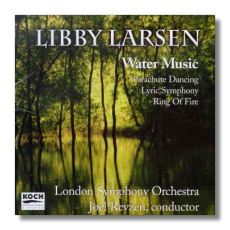
The Internet's Premier Classical Music Source
Related Links
- Larsen Reviews
- Latest Reviews
- More Reviews
-
By Composer
-
Collections
DVD & Blu-ray
Books
Concert Reviews
Articles/Interviews
Software
Audio
Search Amazon
Recommended Links
Site News
 CD Review
CD Review
Libby Larsen

Orchestral Music
- Symphony: Water Music (1984)
- Overture: Parachute Dancing (1983)
- Ring of Fire (1993)
- Symphony Number Three: Lyric (1995)
London Symphony Orchestra/Joel Revzen
Koch 3-7370-2
Executive Summary: Water Music is a vigorous, accessible piece. The formal logic of the Lyric is difficult to follow and the harmonic vocabulary is likely to be rough going for many but the rhythmic gestures are clear cut. There is a great deal of attractiveness in the music but at times I found the content rhetorical in nature.
Libby Larsen is not an innovator. She seems comfortable drawing on whatever musical gestures she needs without sounding particularly derivative. Following her development these last few years what I find is a composer who is growing and developing a personal style. That style is marked by an extroverted, dynamic expression, that is highly rhythmic, filled with energy and expertly orchestrated. The only fly in the ointment is that I don't often find the thematic material to be particularly distinctive. Motive replaces line and yet, to my jaded ears, those motives do not offer much character.
"Water Music" is a tuneful work, filled with shifting moods while maintaining a clear sense of direction. There is plenty that is suggestive of impressionism yet this is not just La Mer or Jeux d'eau revisited, nor is that the only illusion that I noticed. When the melodic line became more clearly defined I found myself being reminded of works like the Bernard Herrmann Symphony. "Water Music" is an outgoing work that offers a great deal of appeal but I found that the emphasis was on gesture versus thematic development. I must admit that after several listenings I still keep looking for point to the music.
The Overture: Parachute Dancing seems to have more character to it. The gestures were more distinctive and are restated often. It made the logic easier to follow but repeated listening turned that aspect into a negative, for the frequent iterations of the material seemed redundant.
Much the same can be said of "Ring of Fire." At times it is an explosive piece, but even after several listenings I kept wondering, "what's the point?" To my ears it was gesture at the expense of development.
With a title like "Lyric Symphony," one might expect to hear something closely akin to the music of Howard Hanson. This is not the case. Larsen, states, "What is lyric in our times? Where is the great American melody? Found, I would say, in the musics of Chuck Berry, Robert Lockwood, Buddy Guy, George Gershwin, James Brown, Dolly Parton, Hank Williams, Aaron Copland, Walter Piston, and those composers who create melodies which are defined more by their rhythm than their pitch." I do not agree with her statement for I find that in great melody pitch and rhythm are on equal footing. Her focus is clearly on rhythm. She has produced an intense work which is rhythmically explosive at times. At times, in the opening of the last movement, I am reminded of the sudden mood shifts, the harmonic structure and the use of sonority as a structural element as can be found in the music of Dutilleux. Repeated listening has left me undecided of the relative merits of Larsen's music, yet there is an appealing quality, an intensity, that keeps me coming back to find the sense of shape to the music.
The playing of the London Symphony is excellent. While scores were not available to me I could not help but thinking that like myself, Revzen kept looking for the overall structure in the work. I wondered if he had maximized the impact of the gestures I might have been more convinced of their viability as a structural element.
The recorded sound is excellent. One concern regarding the overall production can be found at approximately 4:09 in track six, "The Ring of Fire." Perhaps it just an odd sounding acoustic but to my ears it was a fairly noticeable splice in the recording.
(11 November 1997)
Copyright © 1997, Karl Miller


















